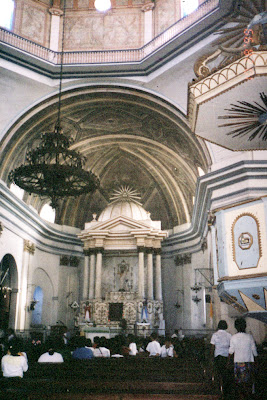Later, accompanied by the HME Embroidery Store caretaker, Jandy and I crossed the street to the 2-storey Felipe Agoncillo Mansion and Monument, birthplace of Felipe Agoncillo, the husband of Marcela who was appointed by Pres. Emilio Aguinaldo as ambassador to the U.S. to campaign for recognition of Philippine independence. He is considered as the first Philippine diplomat. In the well-manicured front garden is a prominent brass statue of Felipe.
| Felipe Agoncillo Mansion and Monument |
Known as the White House, this mansion is also known as the Don Gregorio R. Agoncillo (nephew of Felipe) Museum and is now a National Historical Landmark. As we were accompanied by the store caretaker, we were allowed passage. On the second floor are Edwardian and Spanish-inspired antique, 1800s to early 1900s furniture and choice period items plus busts of the Agoncillo ancestors.
 |
| Agoncillo Mansion dining room |










